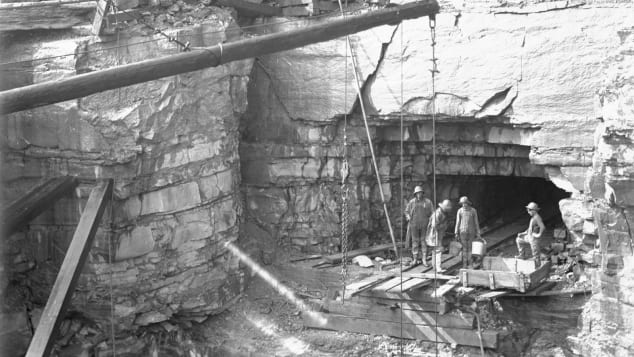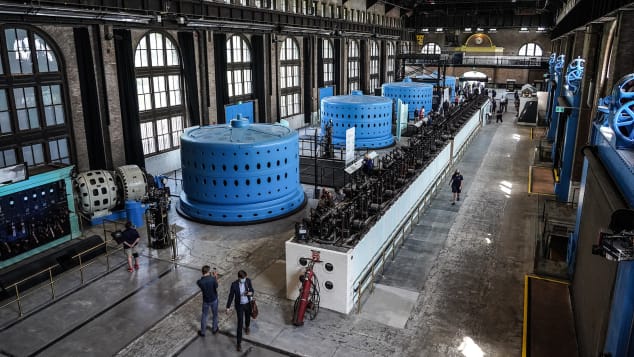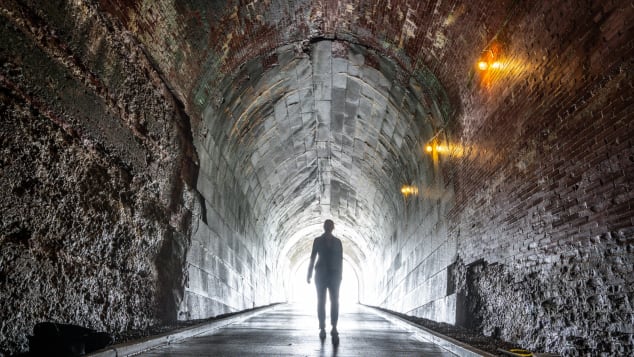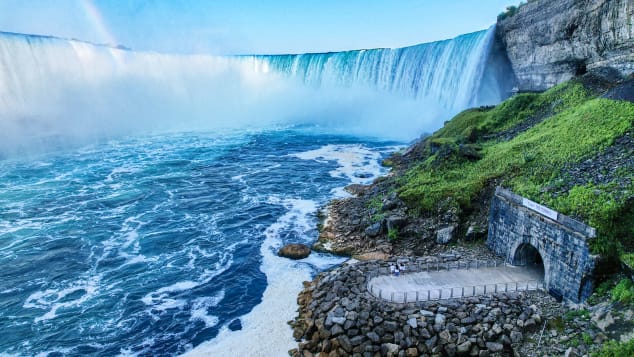세계적으로 명물인, 나이아가라 폭포는 유명인사들, 즉 Marilyn Monroe부터 시작해서 Mark Twain에 이르기까지 200여년동안 지구촌의 여행객들을 자석처럼 끌어들이는 요술 방망이 같은 매력을 지니고, 오늘도 여전히 관광객들로 발 디딜틈이 없을 정도로 붐비는 곳이다.
흔히들, 지구상에서 유명의 3대 폭포가 있다고 전문가들이 설명하고 있는데, 그3개의 폭포중에서 나이아가라폭포가 첫번째, 두번째로는 아프리카의 빅토리아폭포, 그리고 3번째로 남미에 있는 이과수 폭포가 있다.
Cascade처럼 펼쳐져 54미터 밑으로 낙하하는 나이아가라 폭포물이 흘러내리는 그밑으로 드디어 턴넬이 뚫렸다.
나이아가라 폭포는 미국과 캐나다의 국경지역에 소재하고 있어, 양국에서 관리하고 있는데, 관광객입장에서 구경을 즐길수 있는곳은 캐나다쪽이 훨씬더 인기가 많다.
1년에 천만명 이상이 몰리는 나이아가라 폭포는 일년 4계절 관광객들이 전세계로 모여드는 곳이다.
나이아가라 폭포의 낙차는 약 54미터로 알고 있는데, 그 수량은 3대폭포중에서 가장 많다고 하겠다. 특징은 일년 내내 그수량에 변화가 거의 없다는 점이다. 이과수 폭포는 우기와 건기에 따라서 수량이 많이 변화한다. 빅토리아 폭포역시 그런 현상이 일어난다고 하겠는데, 특이한 점은 빅토리아의 폭포의 폭이 자그만치 1킬로가 넘는다는 점이고,폭포가 같은 높이로 보이는 반대편과의 거리는 불과 50에서 100미터 정도밖에 안된다.
나이아가라폭포의 물이 떨어지는 뒷면으로는 오래전부터 턴넬이 뚫려있어, 관람객들은 그곳을 대부분 구경했지만, 사진에서 보는것같은 새로뚫린 턴넬을 통해 폭포아랫쪽에서 폭포를 구경하는것은, 앞으로는 Routine이 될수있다하겠다. 다만 여기를 구경하기위해 관람료가 얼마가 될지는 관람객의 입장에서는 깊이 생각해 보아야할 요소중의 하나가 될것같다.
앞서 언급한것처럼, 이과수폭포, 빅토리아폭포는, 나이아가라폭포처럼 턴넬이 없어, 폭포위의 Watch out에서만 가능하다는 점이다.
https://lifemeansgo.blogspot.com/2007/12/blog-post_12.html
https://lifemeansgo.blogspot.com/2021/05/covid-19-pandemic-lockdown-victoria.html
나이아가라폭포를 중심으로 예전에는 여러개의 수력발전소가 건설되여 인근의 민가에 밤이면 불을 밝혀 생활에 도움을 많이 주었으나, 2022년 7월부터는 발전을 중지시켜, 지금은 폐쇄된 그발전소 공간이 관광객들에게 인기리에 관광명소로 애용되고 있다고 한다.
이발전소가 건설되여 개통되고, 전기불을 밝히면서, 북아메리카의 한쪽 구석에 있는 이곳 나이아가라 폭포지역은 더 많은 관광객들에게 관심이 대상이 되여 왔었다. 다른말로 표현하면, 일종의 현대문명의 햇불역활을 했었다는 뜻이다.
이번에 캐나다쪽에서 개통된 턴넬은 토목사업의 새로운 장을 열었다해도 과언이 아닐 많은 새로운 토목 Engineering의 눈부신 발전상을 동시에 보여주는 쾌거이기도 하다.
100여년전에 670미터길이의 턴넬이 캐나다쪽에서 건설, 관람객들에게 그문을 활짝 개방되면서 그동안 비밀에 쌓여있던 아름답고 획기적인 토목기술로, 숨겨져 있었던 비경이 완전히 관람객들에게 그신비한 비밀을 보여주게 된것이다.
오늘날, Niagara Parks 발전소는 이시대에 오직 수력발전소로 완전하게 가동되여 전력을 생각하고 있는 지구상에서 유일한 보물이다. 원래는 당시로서는 발명가 Nikola Tesla가 특허를 받아 교류를 발전시키는 웨스팅하우스 발전기를 사용하여, 당시로서는 각진부분을 둥그럽게 깍아서, 캐네디언 나이아가라 전력회사에 의해 운영됐었던 것이다.
투어가이드 Zoric씨의 설명에 따르면, 이발전소는 미학적인 규정이 엄격히 적용되는 시기에 건설됐다는 것이다. 러스틱 석회암으로 외부를 장식했으며, 지붕은 파란색 타일로 덮었었고, 이설계는 뉴욕의 건축가 Algernon S. Bell씨가 시도하여 폭포와 구색이 맞추어지는 구조로 건축됐었다는 것이다.
턴넬에 도착하기전에 발전소를 방문하는 사람들에게 폭로로 떨어지는 엄청난 양의 물이 전기로 변화되는 과정을 소형모델로 만들어 전시해주는 과정을 자세히 보여주고 있는 것이다.
나이아가로 폭포의 물이 여러 형태로 변화되여 엄청탄 에너지를 만들어 내고 있다는점이 신기하다. 자연적으로 생성된 아름다움은 물론이고, 또한 우리의 현대생활에 많은 이로움을 주는, 자연의 힘에 대해 여러분들은 한번이 아닌 여러번 생각하게 만들고 있음을 실감하게 될것이다.
발전소와 턴넬을 탐방하는데 약 2시간이 걸리지만, 초저녁에 방문하여 밤샘을 하면서 벌어지는 신기한 쇼를 한번 보기를 강력히 추천한다. 하룻밤 묶으면서 즐길수 있는 호화판 힐튼호텔에서 내려다 보는 폭포의 경관을 볼수도 있고, 경제적인 생각을 염두에 둔다면, Days Inn에서도 불편없이 맘껏 구경할수 있다.
이뉴스가 전세계로 퍼지게되면 더많은 관광객들이 몰려들것으로 예측된다.
(CNN) — A whitewater wonder visited by everyone from Marilyn Monroe to Mark Twain, Niagara Falls has been a magnet drawing global travelers for at least two centuries. But until this year, a huge tunnel buried deep below the cascade has been off-limits to visitors.
The rocks beneath the gigantic triple waterfall that straddles the border between the US state of New York and Canada's province of Ontario are honeycombed with chambers carved out to harness the powerful forces of nature thundering overhead.
And now, a 670-meter (2,198-foot) tunnel built more than a century ago on the Canadian side has been opened up to reveal the awesome scale of these engineering marvels.
Since July 2022, it's been part of tours of the decommissioned Niagara Parks Power Station tour which began a year earlier. Exploring it offers a fascinating glimpse into pioneering work that helped bring this corner of North America into the modern age.
The power station, which operated from 1905 until 2006, diverted water from the mighty Niagara River to run giant generators that electrified regional industry and contributed to the nearby Great Lakes port of Buffalo becoming known as the City of Light.
The region around the waterfall, according to station tour guide Elena Zoric, was once a hub of activity for businessmen who wanted to cash in on harnessing hydro power.
The Adams hydroelectric power plant was the first to open, operating on the US side from 1895 to 1961. On the Canadian side, the Ontario Power Company operated from 1905 to 1999, and the Toronto Power Generating Station from 1906 to 1974.
Blended architecture
The 670-meter tunnel was carved out of the rock more than a century ago.
Niagara Parks
Today, the Niagara Parks station is the world's only fully intact hydroelectric plant of its era. Originally operated by the Canadian Niagara Power Company, it used Westinghouse generators to create alternating currents patented by inventor Nikola Tesla -- cutting-edge technology at that time.
The plant, as tour guide Zoric explains to visitors, was built at a time when aesthetics ruled. Its rustic limestone exterior and blue roof tiles were, she says, an attempt by New York architect Algernon S. Bell to make the structure blend in with the falls.
Before reaching the tunnel, visitors to the power station are shown a scale model of the massive engineering works that went into converting the pounding waters into electricity.
Cyclindrical blue generators once converted the force of the water into electricity.
Niagara Parks
Zoric shows where the water came in, where it ran down a shaft to power the turbines, and then where it went through a tunnel to a discharge point at the base of Horseshoe Falls, the largest of Niagara's three cascades.
Marcelo Gruosso, senior director of engineering and operations with the Niagara Parks Commission, has been involved with the project since it was first envisioned in 2017.
"The plant started out with two generators and, by 1924, all 11 were installed, which you see here today," he says, walking through the high-ceilinged building to point out a line of blue, cylindrical generators that fill the space.
"Beside every generator is a 'governor' which regulated the waterflow to a turbine. An air brake in the governor helped adjust the flow. They needed 250 rpm exactly to give them 25 hertz."
One of a kind
The tunnel once held 71,000 gallons of water moving at nine meters per second.
Niagara Parks
A glass elevator takes visitors down 55 meters past the six levels of infrastructure required for the hydro power generation process. At the bottom is the tunnel where the water would exit.
The tunnel, which is almost eight meters tall and six meters wide, is also an historic, one-of-a-kind attraction and is included in the power plant's price of admission.
"It took thousands of workers four years to excavate the shale beneath the main generating room using lanterns, dynamite, pickaxes and shovels," says Gruosso.
"On its way down, the water would spin the turbine blades," says Gruosso. "They were connected to a 41-meter-long shaft that went all the way back up to the main floor and spun the rotor in the alternator, generating the AC power."
Walking along the tunnel's arched passageway, he gestures to chalky white marks that reach almost to the top of the arched brick walls.
"You can see how high the water went," he says. "The tunnel held 71,000 gallons of water that moved at nine meters per second."
Built like a fortress, the gently curving tunnel comprises four layers of brick and 18 inches of concrete and is surrounded by shale.
"It's amazing what they did with no electricity," notes Gruosso.
"We did some minor brick repairs and added rock anchors to the arch to ensure structural integrity, but it's in really good shape. They only ever did maintenance twice since it was built, once in the 1950s and once in the 1990s."
Unique view
Tourists can now walk out onto a platform to view Niagara Falls.
Niagara Parks
Near the end of the tunnel a rumbling begins to fill the air. Natural light pours in as the path exits onto a 20-meter, river-level viewing platform that is almost at the base of Horseshoe Falls. Gruosso has to shout to be heard over the ceaseless pounding.
"This is where the water from the tunnel poured into the river. It's the best place to see the falls."
The platform also gives visitors a perch to watch the tourist boats, filled with passengers in rain-ponchos, bobbing like corks at the foot of the falls.
To round out the power plant experience there's an evening show titled "Currents: Niagara's Power Transformed." The light and sound experience outlines the power plant's history and includes 3D projections of surging water, turbines and sparks of electricity.
A visit to the power station and tunnel takes around two hours, but to attend the evening show an overnight stay is recommended. Accommodation ranges from higher end Falls-view hotels such as the Hilton, to budget-conscious establishments like the Days Inn.
As for dining, Niagara Falls was once strictly a hotdog and fries kind of town. Fast food is still around but the destination has upped its game. Chef-inspired, locally sourced menus are available at Niagara Parks establishments including Table Rock House Restaurant as well as independent dining spots such as AG which features produce from its own farm.
Also worth checking out is the Niagara Parkway, which winds along the Niagara River and can be explored on foot or by rented e-bike. Stops along the way include Whirlpool lookout point and the Sir Adam Beck Generating Station, a monolithic structure along the river that currently contributes to southern Ontario's electrical grid.
A trip to Niagara Falls is energizing in so many ways. It's a place of natural beauty but it can also make you think twice about the natural forces that continue to shape our modern lives.
http://www.cnn.com/travel/article/niagara-falls-tunnel/index.html





No comments:
Post a Comment